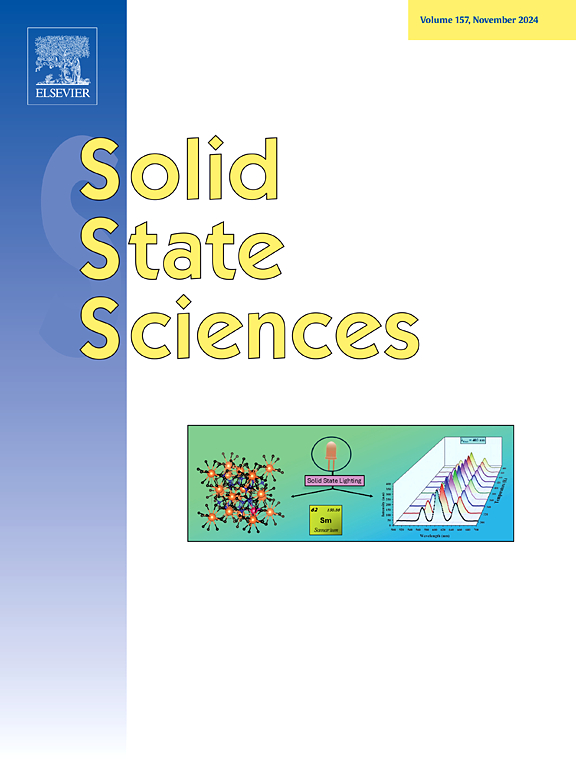新型木质素水凝胶负载Fe/Cu纳米颗粒对过硫酸盐的高效活化降解双酚a
IF 3.4
3区 化学
Q2 CHEMISTRY, INORGANIC & NUCLEAR
引用次数: 0
摘要
本文合成了一种新型木质素水凝胶负载的Fe/Cu纳米复合材料(LH-Fe/Cu),通过过硫酸盐(PS)活化降解水溶液中的双酚a (BPA),即LH-Fe/Cu- PS体系。详细的性能数据表明,木质素水凝胶独特的三维(3D)结构有利于磁性纳米颗粒(Fe/Cu颗粒)的分散,从而提高了Fe/Cu颗粒的最大暴露度。木质素水凝胶的三维结构增强了Fe/Cu、PS和BPA的附着位点的可用性,促进了Fe/Cu和PS之间的有效电子转移,从而促进了BPA的降解。在0.06 g/L催化剂和0.8 mM PS条件下,6 min内,LH-Fe/Cu-PS体系对BPA的降解率达到98.58%,并研究了腐植酸(HA)和无机阴离子对降解过程的影响。淬灭实验表明,LH-Fe/Cu-PS体系主要产生活性自由基SO4。-、。oh和O2。-,含SO4。-作为原始物种。通过密度泛函理论(DFT)计算和中间分析,预测了双酚a的降解机理和途径。LH-Fe/Cu-PS系统对水污染物的降解效果显著,在有机废水处理中具有很大的应用潜力。本文章由计算机程序翻译,如有差异,请以英文原文为准。

Efficient activation of persulfate by a novel lignin hydrogel supported Fe/Cu nanoparticles for bisphenol A degradation
In this work, a novel lignin hydrogel-supported Fe/Cu nanocomposite (LH-Fe/Cu) was synthesized for the degradation of bisphenol A (BPA) in aqueous solution through persulfate (PS) activation, namely the LH-Fe/Cu-Ps system. The detailed property data demonstrated that the unique three-dimensional (3D) structure of the lignin hydrogel facilitates the dispersion of magnetic nanoparticles (Fe/Cu particles), thereby enhancing the maximum exposure of Fe/Cu particles. The three-dimensional architecture of lignin hydrogel enhances the availability of attachment sites for Fe/Cu, PS, and BPA, facilitating efficient electron transfer between Fe/Cu and PS, thereby promoting the degradation of BPA. The degradation rate of BPA in the LH-Fe/Cu-PS system reached 98.58 % within 6 min with 0.06 g/L catalyst and 0.8 mM PS. The effects of humic acid (HA) and inorganic anion on the degradation process were also studied. The quenching experiment demonstrated that the LH-Fe/Cu-PS system predominantly generates active free radicals, namely SO4.-, .OH, and O2.-, with SO4.- being the primary species. The degradation mechanism and pathway of BPA were predicted through density functional theory (DFT) calculations and intermediate analysis. The LH-Fe/Cu-PS system exhibits remarkable efficacy in the degradation of water pollutants and holds significant potential for application in the treatment of organic wastewater.
求助全文
通过发布文献求助,成功后即可免费获取论文全文。
去求助
来源期刊

Solid State Sciences
化学-无机化学与核化学
CiteScore
6.60
自引率
2.90%
发文量
214
审稿时长
27 days
期刊介绍:
Solid State Sciences is the journal for researchers from the broad solid state chemistry and physics community. It publishes key articles on all aspects of solid state synthesis, structure-property relationships, theory and functionalities, in relation with experiments.
Key topics for stand-alone papers and special issues:
-Novel ways of synthesis, inorganic functional materials, including porous and glassy materials, hybrid organic-inorganic compounds and nanomaterials
-Physical properties, emphasizing but not limited to the electrical, magnetical and optical features
-Materials related to information technology and energy and environmental sciences.
The journal publishes feature articles from experts in the field upon invitation.
Solid State Sciences - your gateway to energy-related materials.
 求助内容:
求助内容: 应助结果提醒方式:
应助结果提醒方式:


